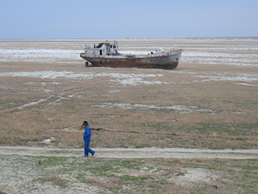Aral Sea

Staecker, via Wikimedia Commons
Investigations 1, 17
- Ships in a Field (Set of Images - Investigation 1, 17) - [Power Point] [pdf]
- Why are these ships in a field? The Story of the Aral Sea (Student Reference - Investigation 17) - [pdf]
Why are these ships in a field?
The images of ships in a "field' - actually a dry inland seabed - pose a mystery for the students, and as importantly, they highlight the extraordinary scale at which evaporation occurs. Over 70,000 cubic kilometers of water evaporate from Earth's land surfaces each year. Usually that water is replaced by rain and snow, and distributed by the rivers that keep lakes and other inland bodies of water replenished. This replenishment typically hides the effect of evaporation. But what happens if rivers are diverted, so that they no longer replace the water that evaporates? When evaporation removes more water than comes into a body of water, the water level will drop until over time until the body of water disappears. This is the story behind ships in a field.
The mystery of the ships is presented to students in Investigation 1, in the form of a set of images. We recommend leaving both the location and the full story behind the disappearance of the water a mystery until after students have had their own set of experiences with evaporation and condensation. The curriculum returns to the images in Investigation 17, when we suggest you share the story behind the images; that is, the story of the Aral Sea in central Asia.
In 1960, the Aral Sea was the world's 4th largest inland body of water. Its surface area exceeded 67,000 square kilometers, greater than the surface area of Lake Huron. It supported a substantial fishing industry. In the 1960's, vast amounts of water from the two rivers that feed into the lake started being diverted to provide irrigation for cotton fields. By the 2007 the level of the lake had dropped so much that 90% of its former area was dry land. The water that remains - in the deepest parts of the original lake - is now separated into smaller bodies of water that are so salty that fish can no longer survive. The countries that border the former sea are considering plans for reversing this decline, but so far no significant actions have been taken.
Student questions
When students see the images, they will wonder what happened to the water, but their questions are likely to go beyond that.
- They may ask if the water sank into the ground.
The land below the sea would remain saturated, and would not be able to absorb additional water until after the sea had evaporated. The land did not absorb the sea. The water evaporated. - They may wonder why the ships were just abandoned, rather than being moved to somewhere else.
Unlike recreational boats, commercial ships are usually built on the shoreline of the body of water in which they will sail. They are too large to move across land. They can't really go anywhere. In addition, once the fishing industry collapsed, most of the ships were of no use, even if they could have moved to the parts of the lake that remain. - They may wonder what happened to the people on the ships.The evaporation of water from the lake occurred across decades. It was not a sudden event. No one was caught stranded on a ship that suddenly found itself on dry ground. People probably left the ships while they were still tied up beside a pier, and long before the ships ended up on dry ground.
Remember to highlight the fact that this is a story about the evaporation of water, the enormous scale at which it happens, and what happens when water that evaporates is not replaced. It's the same story - at a different scale - as the story of a puddle after the rain stops.



